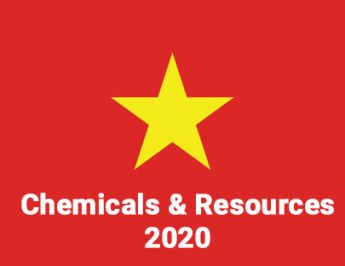
The Chemicals and resources in Vietnam report from Statista brings comprehensive information about the exploitation and use of minerals and natural resources in Vietnam from 2009 to 2020.

Vietnam was known as a country with diverse mineral resources with more than 5000 mines of 60 types of minerals. This also contributes to the GDP of the country in the development phase. Let's find out more specifically about the mining industry and environmental resources in Vietnam over the past 10 years.
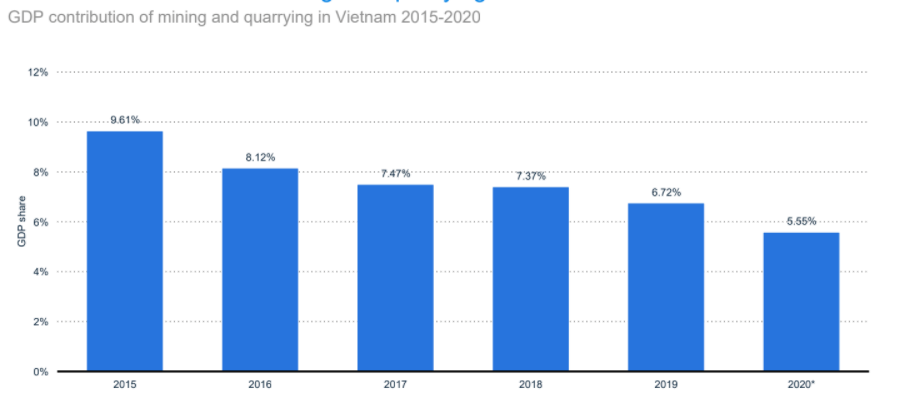
In 2020, the mining and quarrying sector reached 349.43 trillion VND (approx. 15.3 billion U.S. dollars), contributed 5.55% to the total GDP of the country (340.82 billion U.S. dollars), down 8.6% compared to the previous year (405.8 trillion VND in 2019). The share of GDP in mining and quarrying has decreased continuously since 2015 (at 9.61%) to 7.37% in 2018 and 5.55% in 2020. This is the most profound drop since 2015. According to the General Statistics Office of Vietnam, the main reason was due to the decrease in crude oil and natural gas production.
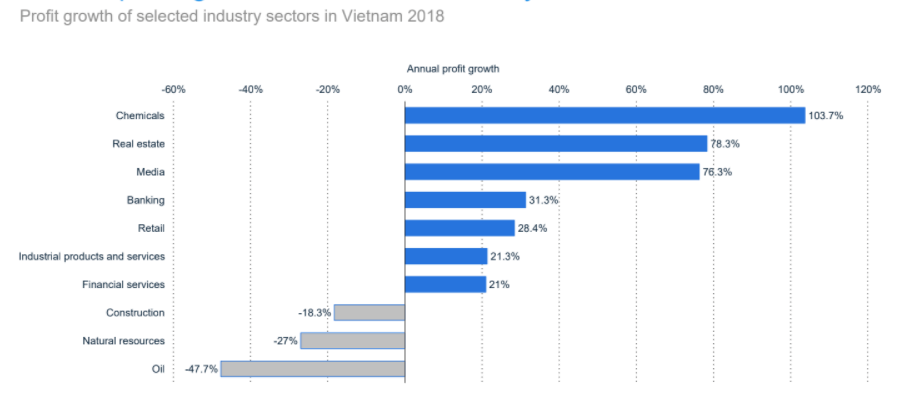
The profit growth of selected industry sectors in Vietnam in 2018 tended to increase the most in the Chemicals sector, with a significant growth rate of 103%, Real estate. Media followed with an annual profit growth rate of over 70%, and other sectors such as Banking and Retail with 31.3% and 28.4% respectively, Industrial products and services, Financial services with annual profit growth of about 21%—negative annual profit growth in the fields of Construction, Natural resources, Oil.
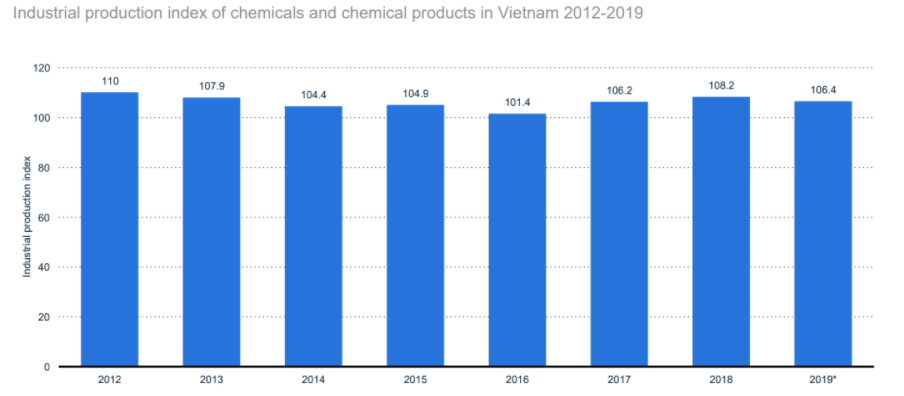
The PPI of chemicals in Vietnam from 2015-2020 has steadily increased over the years. In 2020, PPI in chemicals reached 131.05 index points, increasing more than 31 points compared to 2010 (PPI in chemical equations to 100 index points). The merchandise export price index for chemicals in Vietnam tended to increase steadily from 2015 to 2020. Meanwhile, the merchandise import price index grew very slowly and showed signs of slowing down.
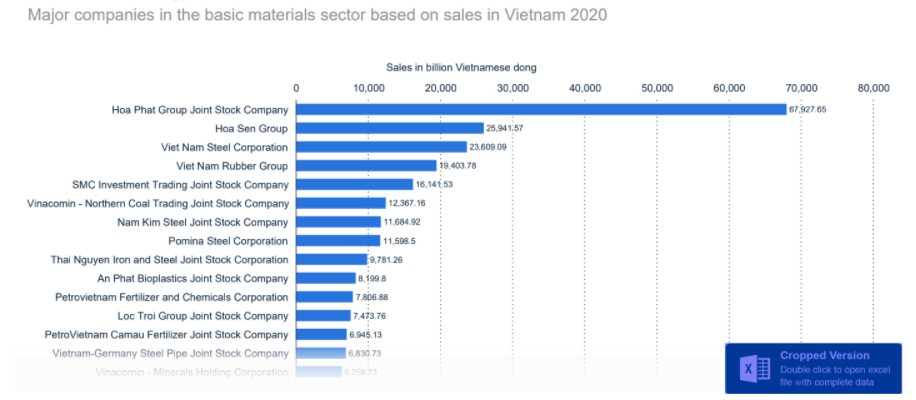
The report also brings a list of leading companies in the basic materials sector based on sales in Vietnam in 2020. Hoa Phat Group Joint Stock Company leads with sales in 2020 reaching nearly 68 billion VND. They are followed by Hoa Sen Group and Vietnam Steel Corporation, with about 26 and 23.6 billion VND, respectively. Hoa Phat Group JSC, Hoa Sen Group, and Vietnam Steel Corporation generate most of their revenue from producing and distributing steel.
In 2021, Hoa Phat Group ranked 4th among the 500 largest private enterprises in Vietnam with dozens of subsidiaries and more than 25,000 employees nationwide, plus 1 representative office in Singapore. In its fields of activity, the production and trading of steel-related products is still the core of Hoa Phat, accounting for over 80% of its revenue and profit. Accumulated in the first 6 months of 2021, the Group recorded revenue of nearly VND 66,900 billion, up 67% over the same period.
Fertilizers and chemicals production and trading increased sharply
As an agricultural country, Vietnam always attaches great importance to the development of chemicals for agriculture. The strategy for domestic fertilizer production continues to increase production at 10%/year. However, our country's current fertilizer production capacity can meet only 45% of the demand for agricultural use. The weakness of this domestic chemical fertilizer industry is that it is not diversified in fertilizer types.
The chemical industry in Vietnam mainly serves agriculture, industrial production, and consumption. The chemical fertilizer production volume in 2020 reached approximately 50.96 thousand metric tons, indicating a continuous increase in the period of 4 years from 2017 to 2020.
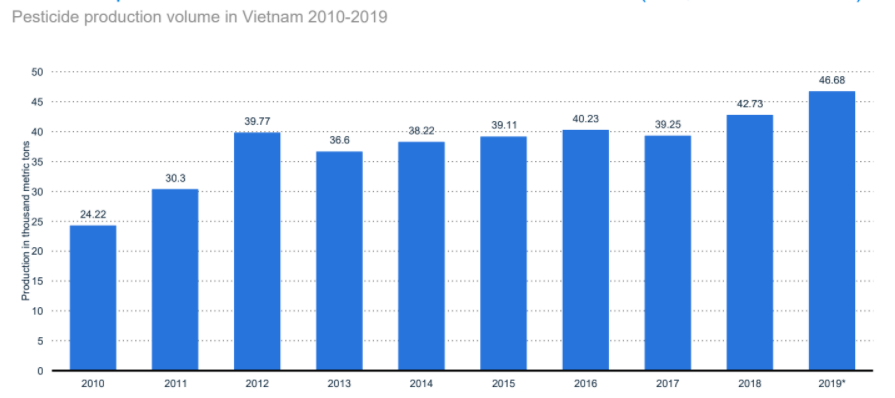
As an agricultural country, in a temperate climate zone, with many insects all year round, the consumption and production of pesticides and insecticides in Vietnam also tend to increase over the years. The insecticide production in Vietnam has increased continuously over the last decade and from 2018 to 2019. The insecticide production in Vietnam in 2019 reached 166.5 thousand metric tons, an increase of 26.5 thousand metric tons compared to 2018.
Vietnam's natural gas source predicted to decline from 2022
The report showed that the natural gas production in Vietnam had been steady growth for the last decade. In 2-19, the natural gas production reached 9.9 billion cubic meters, increasing 0.2 billion cubic meters compared to 2018. The gas industry growth met the domestic consumption requirements, with the gas consumption recorded in 2019 equal to the production volume, reaching 9.9 billion cubic meters.
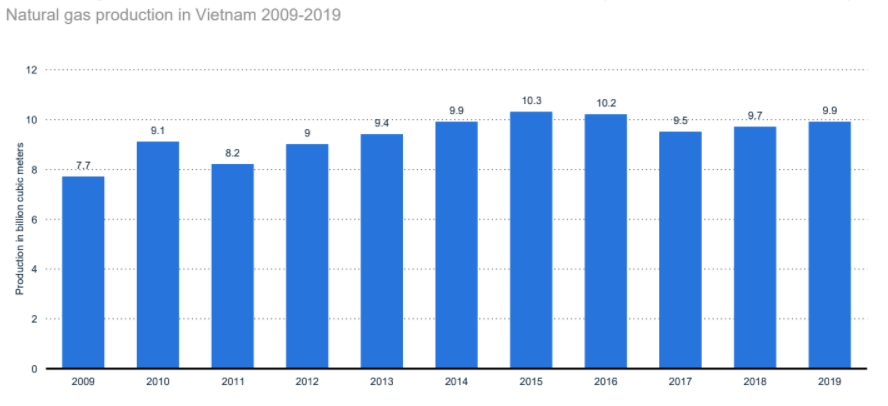
Vietnam is one of the countries that have large coal reserves in Asia. Currently, coal mining in Vietnam is divided into two main types: underground (accounting for 55%) and open-pit or opencast mining (accounting for 45%). The coal production in Vietnam in 2019 reached 1.08 exajoules. Mining volume only meets 50% of coal consumption demand in Vietnam, as shown in the report of Vietnam coal consumption in 2019 is 2.07 exajoules.
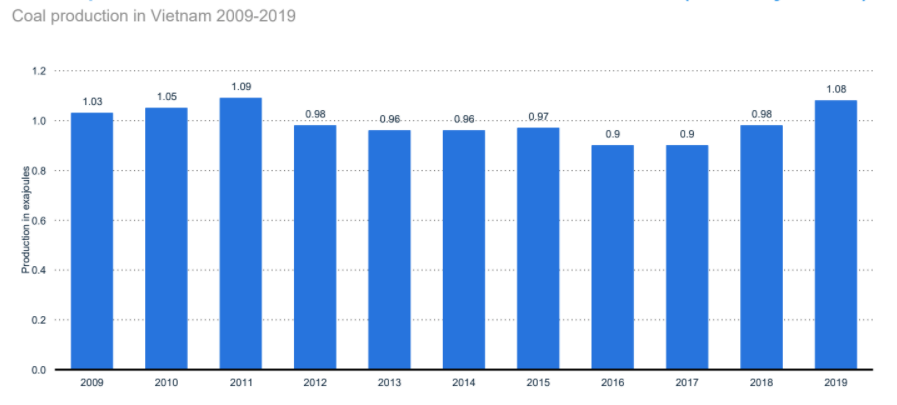
Currently, Vietnam ranks 4th in Southeast Asia in terms of oil exports. Vietnam is likely to maintain production at around 340,000 BPD in the next few years.

According to Statista, domestic oil production in Vietnam in 2019 reached 236 thousand barrels a day, the most profound decline since 2015. The oil production in 2015 reached 352 thousand barrels a day, the highest of the decade. In contrast, the oil consumption in Vietnam increased steadily across the year, reaching 528 thousand barrels a day. The oil consumption in 2019 is 2 times higher than the volume of the same year.
There are more than 300 iron ore mines and sites and are mainly concentrated in the northern provinces in Vietnam. Others scattered in many places and distributed from the North to the Central region. According to Statista, Vietnam's iron ore production volume will increase rapidly from 2017 to 2019, reaching around 5 million metric tons per year. This volume was around 2 million from 2011 to 2015.
In contrast, the copper ore showed a lower production volume which reached 86.29 thousand metric tons in 2019, the highest in a decade. Titan ore production volume in Vietnam 2019 reached 271.1 thousand metric tons, higher than the year before but still low compared to the production volume from 2013 and earlier years. The Titan ore production volume in Vietnam in 2013 reached 1025.8 thousand metric tons, 3.7 times higher than production volume in 2019.
Antimony mining and processing have been carried out in Vietnam since the 70s of the last century. Depending on the ore characteristics, different sieving and deep processing technologies can be used. Antimony sulfide ores can be treated by both pyrometallurgy and hydrometallurgy. The antimony ore production volume in Vietnam in 2019 reached 764 metric tons, higher than the year before and remaining around the minimum volume compared to the highest production volume in 2014, which reached 2745 metric tons.

Apatite ore is one of the major minerals in Vietnam. The dolomite apatite ore has large reserves and is mainly distributed in the Lao Cai province of Vietnam. The apatite ore production is mainly used for the phosphate fertilizer industry in Vietnam. That's why apatite ore mining plays an essential role in providing raw materials for fertilizer production. The Statista report indicated the apatite ore production volume in 2019 reached 4.65 million metric tons, the highest volume in the past decade.
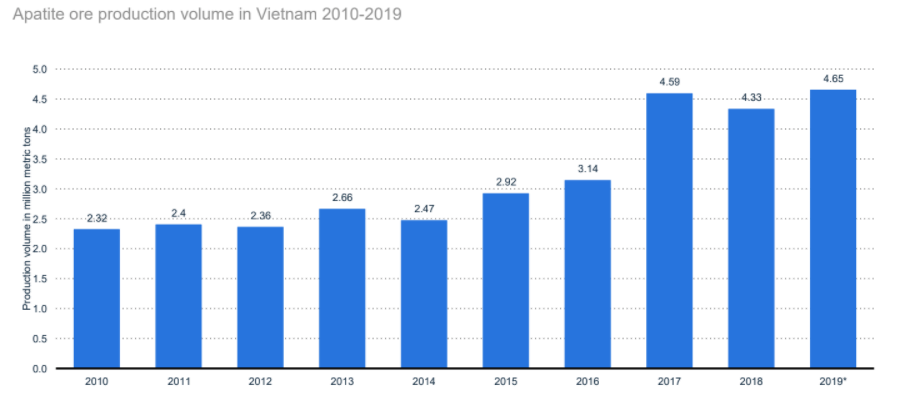
Strong development to meet the increasing domestic and export demand
After signing Free Trade Agreements (FTAs), Vietnam's businesses have more opportunities to export plastic products. Partners are gradually shifting orders from China to Vietnam to take advantage of cheap production costs and export tax to enjoy many incentives. At the same time, the demand for importing plastic products in the European markets (EU) and Japan is still high, while customers in these countries increasingly prefer Vietnamese plastic products.
As a result, the industrial production index of rubber and plastics products in Vietnam 2019 gained 114, the highest from 2012 up to the present time. The plastic industry mainly adapts to domestic demand. That's why we can see the domestic demand for plastic resin in Vietnam in 2020 reached 6.92, the highest rate since 2014. The Statista report predicts that the domestic demand for plastic resin in Vietnam will reach 8.23 billion metric tons, increasing more than 2 billion tons for the next 2 years.
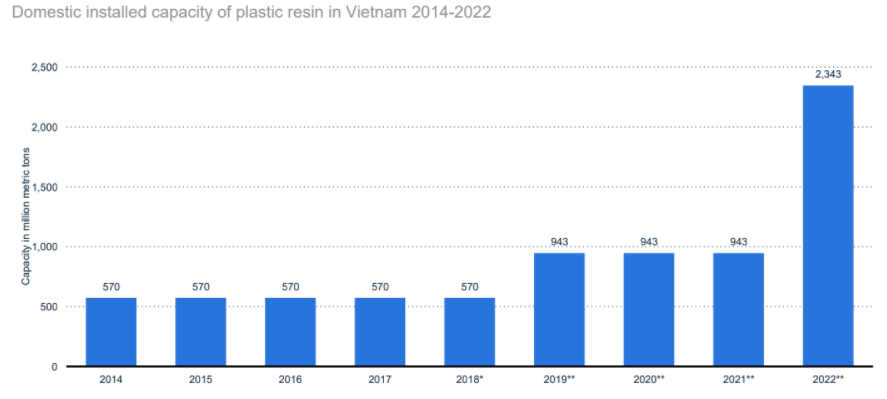
An average growth rate of about 10-12% per year since 2010
The strong development of digital communication has led to a decrease in the demand for newsprint and brought strong growth in the segment of packaging serving online sales and delivery. The Statista report showed a slight increase in paper production volume in Vietnam in 2019, reaching 2.4 million metric tons, showing an increase of 0.29 million metric tons compared to 2018. The paper production volume in 2019 is also higher than the period from 2010 to 2018.

The chemical industry in Vietnam mainly serves agriculture, industrial production, and consumption, accounting for a significant proportion in the industrial structure, with a ratio of 11.2%. However, compared with newly developed countries in Southeast Asia, the chemical production capacity in Vietnam is still low. Besides, as a country with diverse mineral resources with more than 5000 mines of 60 types of minerals, Vietnam's mining industry still has potential for development. However, mineral development needs to go hand in hand with conservation and prevention of possible future consequences, such as erosion, land subsidence, loss of biodiversity, soil pollution, groundwater, and surface water due to chemicals from ore processing. Download full report or contact our consultant team to get support!